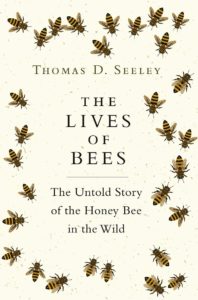Review of Thomas D. Seeley’s “The Lives of Bees”
North America has no native honeybee species. They were brought here by Europeans arriving in the 17th century – and now play a crucial role in American agriculture.
Despite their foreign origin, honeybees have persisted in a landscape that offers few of their familiar flowers. Their hives produce honey, wax, pollen, royal jelly and propolis – products humans have valued for centuries. Humans keep honeybees as livestock, yet honeybee colonies retain the ability to swarm, escape and live in the wild.
It’s these feral colonies that have especially interested Thomas D. Seeley, author of “The Lives of Bees: The Untold Story of the Honey Bee in the Wild.” He began observing wild honeybees in the 1960s as a kid in the Finger Lakes area near Ithaca, New York. Since then, he’s become a world expert on these insects, which have lived with humans for millennia.
Thomas’ message is this: To keep a colony of honeybees at its healthiest, the beekeeper should simulate the conditions of healthy feral colonies in the local area. Among those conditions, Thomas writes, are hive location and construction; diet; adaptation to disease and parasites (like the notorious varroa mite); and defenses against animals that would steal from the hive. One question he’s sought to understand from years of observing both managed and feral colonies is how wild colonies succeed in making new generations of queens and drones, and ultimately, new colonies.
If you’re open to ideas and short on time, consider starting with Chapter 11, “Darwinian Beekeeping.” This chapter shares 14 practices, based on observations of feral honeybees, that may benefit managed colonies. A beekeeper might choose one or a few practices to explore further from the list, then test them using a small number of hives. For example, Thomas advises beekeepers to provide hives with thicker walls so they’re better insulated for temperature changes. Or offer hives rough interior walls, which could encourage bees to coat them with propolis – a resin-like material bees make to build hives that may also help fight against parasites.
Many of Thomas’ recommendations seem straightforward for small-scale beekeepers to try. Without the pressure of fulfilling contracts, these operations have more flexibility to field-test the practices he suggests. Commercial beekeepers, however, who truck their hives long distances, would face challenges adopting some of this advice. For example, Thomas recommends getting queens that are local and have mated with drones through natural competition – but any “local advantage” is likely lost when hives are trucked from Florida to California.
Chapters 2 through 10 describe Thomas’s detailed research on beekeeping practices and data collected from his observations. Readers will learn about the lives of wild bees, the nature of the colony and its annual cycle, reproduction, food collection, temperature control and colony defense. The book also looks at the history of beekeeping and includes references to published academic research.
Thomas points out that his observations in the Finger Lakes region may not apply as well to other locales. One key difference is that 37.1% of the land in New York is considered public land. Iowa, by contrast, has only 2% of its land in public land. New York is known for its forests, which offer more hollow trees where a feral colony might establish.
Once you leave an Iowa river or creek, large trees with hollows for a beehive may be hard to find. But resourceful honeybees can take up residence in sheds, under porches and in houses – my grandmother had hives move into her attic nearly every June during the 1970s. Bears are less a hazard in the Midwest, though skunks and raccoons do raid hives.
Another challenge for honeybees in Iowa is that two crops, corn and soybeans, dominate the landscape; yet honeybees benefit from nectaring on a variety of plants, ideally those not treated with insecticides or fungicides. These widely used chemicals can drift onto road ditches, buffers – and even family tomato patches. The result is that the areas we might think are available for pollinator habitat are actually toxic to them.
If you’re not ready to keep bees, you can still help them by planting bee-friendly flowering plants such as beebalm and lavender – or simply by not killing dandelions, a European import that honeybees visit.
Ka thy Bine worked as a technical writer for 35 years, and volunteered for a decade as a docent in the Invertebrate Exhibit at the National Zoo in Washington, D.C. She lives in Fairfax, Virginia, and owns family farmland north of Beaman in Grundy County, Iowa.
thy Bine worked as a technical writer for 35 years, and volunteered for a decade as a docent in the Invertebrate Exhibit at the National Zoo in Washington, D.C. She lives in Fairfax, Virginia, and owns family farmland north of Beaman in Grundy County, Iowa.

